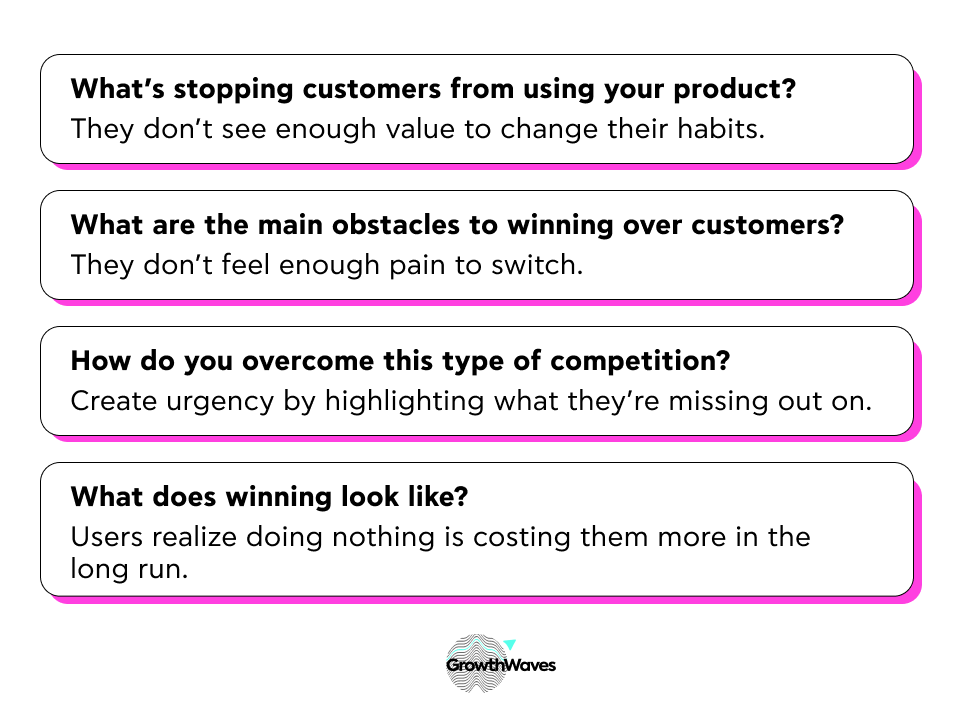Status quo competition
Rethinking competition beyond direct and indirect rivals
👋 Hey, I’m George Chasiotis. Welcome to GrowthWaves, your weekly dose of B2B growth insights—featuring powerful case studies, emerging trends, and unconventional strategies you won’t find anywhere else.
This Note of GrowthWaves is brought to you by SERP Conf.
On March 25th, I’ll be speaking at SERP Conf. Sofia—one of the best SEO conferences in the Balkans.
If you want to learn from top minds in the industry and meet great people, this is the place to be.
Last year’s event sold out, and tickets for this year’s event are moving fast.
Grab yours, and use the code ‘minuttia-15’ for 15% off.
Visit SERP Conf. to buy your ticket.
A few days ago, I posted about a concept I’ve been thinking about for a while.
It’s called ‘Status quo competition,’ and it’s precisely what you’d guess.
Let me unpack it for you and explain why it’s important.
Status quo competition
Most companies think they know who their competitors are.
They…
1) Build sheets with different attributes they update quarterly or when a change happens (e.g., strategy)
2) Monitor their competitors on review sites (e.g., G2) and track their product features, brand mentions, traffic, and backlinks
3) Use competitive intelligence tools to build battlecards so that they get on demos and sales calls prepared
But the truth is that companies spend too much time stressing over their competitors. Worse, their view of competition is usually limited to their direct and indirect competitors.
Take Clay as an example. Suppose Clay's primary use case is setting up enrichment automations. In that case, you’d consider Freckle a direct competitor (it’s even part of their positioning) and a tool like Lusha an indirect one. As far as I know, Lusha doesn’t offer workflows and is mainly used for lead enrichment. You could fit it into your workflow; it would be slightly inconvenient, but depending on the use case, it could do the job.
The problem is that your direct and indirect competitors are just one part of the comparison landscape. Companies mainly focus on the charted part. What about the uncharted part of the competitive landscape, though? If the tool is Clay (as in our example), then you’d have all these individuals and companies using sheets, writing their own scripts, and orchestrating different APIs to build GTM workflows.
Editor Note: We’re keeping the LinkedIn post's original graph for consistency.
A good way to understand how buyers perceive competition for a particular product is to search for it on Google. In our example, searching for something like ‘clay alternatives’ on Google is enough. One of the first search results comes from Reddit. The following two comments stand out as they’re very relevant to the point I’m trying to make:

You could argue that comments from anonymous Reddit users (which could easily be incentivized or biased for whatever reason) aren’t representative of the typical Clay buyer. Even though there’s some truth to that, these two comments are very close to representing another kind of competition that’s usually not included in competitive matrixes: Status quo competition
Status quo competition
Considering only your direct and indirect competitors when conducting competitive analysis is a problem because it creates a myopic view of the alternatives. Companies will talk about their (known) competitors and make assumptions about what they don’t know or what their prospects and customers won’t tell them.
But very often, it’s something you don't know that prevents you from hitting your pipeline and revenue goals, not what or who you think you do.
And with AI being the catalyst and enabler for status quo competition (read: people can build stuff themselves more easily and at a fraction of the cost), you have to take a step back and redefine who your actual competitors are.
To understand status quo competition, you need to answer the following questions:
As it is evident from this set of questions, status quo competition is based on the premise that buyers don’t feel the need to change their habits. In other words, they feel comfortable with the status quo and don’t want to do anything that would change that.
Besides the desire to change (often a weak motivator), they don’t feel enough pain to justify getting out of their comfort zone and changing their habits. To overcome this, you must focus on the cost of doing nothing and the ‘pain’ they’ll feel in the long run.
Fighting against status quo competition is more challenging than fighting against direct and indirect competitors. In most cases, competing against the status quo is difficult because you don’t know what you’re fighting against. Ultimately, changing someone’s habits and convincing them to experience discomfort (in the form of a learning curve, cost, or time) is way more difficult than pushing them toward a simple software vendor change.
What I want you to take away from this note
If I had to choose what I’d like you to take away from this note, it’d be the graph and the set of questions you need to answer to (better) understand your status quo competition.
This isn’t an esoteric and theoretical concept. It has a practical application that can be powerful for your company. Understanding and addressing status quo competition is equally important (if not more) as mapping the competitive landscape for your indirect and indirect competitors.
The graph and questions will guide you.





Indeed that is a real problem that founders who don't think strategically enough often miss. There is a spectrum depending on the case. We see it regularly with productivity apps and how each compares to Notion, as well as the reverse of it when professionals and businesses are looking for niche SaaS that specialize in what they are solving [https://youtu.be/ERarYs2KVPI].